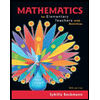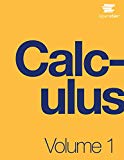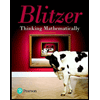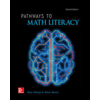
Discrete Mathematics With Applications
5th Edition
ISBN: 9781337694193
Author: EPP, Susanna S.
Publisher: Cengage Learning,
expand_more
expand_more
format_list_bulleted
Question
Chapter 11.5, Problem 14ES
To determine
(a)
Use iteration to guess an explicit formula for
To determine
(b)
Prove that if k is an integer and x is a real number with
To determine
(c)
Prove that for all integers
To determine
(d)
Prove the correctness of the formula you found in part (a).
Expert Solution & Answer
Trending nowThis is a popular solution!

Students have asked these similar questions
Solve the following Integer Programming problem using the branch and bound algorithm. Choose x1 as branching variable in the first branching. n=5, s=13.
Discrete Maths Oscar Levin 3rd eddition 4.3.9:
Prove Euler’s formula using induction on the number of vertices in the graph.
ps: I'd be so glad if you include every detail of the solution. & Thank you soooo much. You are doing a great job ?
(a)
Consider the following algorithm segment:
for i:= 1 to 8
for j:= 1 to i
[Statements in the body of the inner loop.
None contain branching statements
that lead outside the loop.]
next j
next i
How many times will the inner loop be iterated when the algorithm is implemented and run?
(b)
Let n be a positive integer, and consider the following algorithm segment:
for i:= 1 to n
for j:= 1 to i
[Statements in the body of the inner loop.
None contain branching statements
that lead outside the loop.]
next j
next i
How many times will the inner loop be iterated when the algorithm is implemented and run?
Chapter 11 Solutions
Discrete Mathematics With Applications
Ch. 11.1 - If f is a real-valued function of a real variable,...Ch. 11.1 - Prob. 2TYCh. 11.1 - Prob. 3TYCh. 11.1 - Prob. 4TYCh. 11.1 - Prob. 5TYCh. 11.1 - Prob. 6TYCh. 11.1 - Prob. 1ESCh. 11.1 - The graph of a function g is shown below. a. Is...Ch. 11.1 - Prob. 3ESCh. 11.1 - Sketch the graphs of the power functions p3 and p4...
Ch. 11.1 - Prob. 5ESCh. 11.1 - Prob. 6ESCh. 11.1 - Prob. 7ESCh. 11.1 - Sketch a graph for each of the functions defined...Ch. 11.1 - Prob. 9ESCh. 11.1 - Prob. 10ESCh. 11.1 - Prob. 11ESCh. 11.1 - Prob. 12ESCh. 11.1 - Prob. 13ESCh. 11.1 - The graph of a function f is shown below. Find the...Ch. 11.1 - Prob. 15ESCh. 11.1 - Prob. 16ESCh. 11.1 - Prob. 17ESCh. 11.1 - Prob. 18ESCh. 11.1 - Prob. 19ESCh. 11.1 - Prob. 20ESCh. 11.1 - Prob. 21ESCh. 11.1 - Prob. 22ESCh. 11.1 - Prob. 23ESCh. 11.1 - Prob. 24ESCh. 11.1 - Prob. 25ESCh. 11.1 - Prob. 26ESCh. 11.1 - Prob. 27ESCh. 11.1 - Prob. 28ESCh. 11.2 - A sentence of the form Ag(n)f(n) for every na...Ch. 11.2 - Prob. 2TYCh. 11.2 - Prob. 3TYCh. 11.2 - When n1,n n2 and n2 n5__________.Ch. 11.2 - Prob. 5TYCh. 11.2 - Prob. 6TYCh. 11.2 - Prob. 1ESCh. 11.2 - Prob. 2ESCh. 11.2 - The following is a formal definition for ...Ch. 11.2 - In 4—9, express each statement using -, O-, or ...Ch. 11.2 - In 4—9, express each statement using -, O-, or ...Ch. 11.2 - Prob. 6ESCh. 11.2 - Prob. 7ESCh. 11.2 - Prob. 8ESCh. 11.2 - Prob. 9ESCh. 11.2 - Prob. 10ESCh. 11.2 - Prob. 11ESCh. 11.2 - Prob. 12ESCh. 11.2 - Prob. 13ESCh. 11.2 - Use the definition of -notation to show that...Ch. 11.2 - Prob. 15ESCh. 11.2 - Prob. 16ESCh. 11.2 - Prob. 17ESCh. 11.2 - Prob. 18ESCh. 11.2 - Prob. 19ESCh. 11.2 - Prob. 20ESCh. 11.2 - Prove Theorem 11.2.4: If f is a real-valued...Ch. 11.2 - Prob. 22ESCh. 11.2 - Prob. 23ESCh. 11.2 - a. Use one of the methods of Example 11.2.4 to...Ch. 11.2 - Suppose P(n)=amnm+am1nm1++a2n2+a1n+a0 , where all...Ch. 11.2 - Prob. 26ESCh. 11.2 - Prob. 27ESCh. 11.2 - Prob. 28ESCh. 11.2 - Use the theorem on polynomial orders to prove each...Ch. 11.2 - Prob. 30ESCh. 11.2 - Prob. 31ESCh. 11.2 - Prob. 32ESCh. 11.2 - Prove each of the statements in 32—39. Use the...Ch. 11.2 - Prob. 34ESCh. 11.2 - Prob. 35ESCh. 11.2 - Prob. 36ESCh. 11.2 - Prob. 37ESCh. 11.2 - Prob. 38ESCh. 11.2 - Prob. 39ESCh. 11.2 - Prob. 40ESCh. 11.2 - Prob. 41ESCh. 11.2 - Prob. 42ESCh. 11.2 - Prob. 43ESCh. 11.2 - Prob. 44ESCh. 11.2 - Prob. 45ESCh. 11.2 - Prob. 46ESCh. 11.2 - Prob. 47ESCh. 11.2 - Prob. 48ESCh. 11.2 - Prob. 49ESCh. 11.2 - Prob. 50ESCh. 11.2 - Prob. 51ESCh. 11.3 - When an algorithm segment contains a nested...Ch. 11.3 - Prob. 2TYCh. 11.3 - Prob. 3TYCh. 11.3 - Suppose a computer takes 1 nanosecond ( =109...Ch. 11.3 - Prob. 2ESCh. 11.3 - Prob. 3ESCh. 11.3 - Exercises 4—5 explore the fact that for relatively...Ch. 11.3 - Prob. 5ESCh. 11.3 - Prob. 6ESCh. 11.3 - Prob. 7ESCh. 11.3 - Prob. 8ESCh. 11.3 - Prob. 9ESCh. 11.3 - For each of the algorithm segments in 6—19, assume...Ch. 11.3 - For each of the algorithm segments in 6—19, assume...Ch. 11.3 - For each of the algorithm segments in 6—19, assume...Ch. 11.3 - Prob. 13ESCh. 11.3 - Prob. 14ESCh. 11.3 - For each of the algorithm segments in 6—19, assume...Ch. 11.3 - Prob. 16ESCh. 11.3 - For each of the algorithm segments in 6—19, assume...Ch. 11.3 - Prob. 18ESCh. 11.3 - Prob. 19ESCh. 11.3 - Prob. 20ESCh. 11.3 - Prob. 21ESCh. 11.3 - Construct a trace table showing the action of...Ch. 11.3 - Construct a trace table showing the action of...Ch. 11.3 - Prob. 24ESCh. 11.3 - Prob. 25ESCh. 11.3 - Prob. 26ESCh. 11.3 - Consider the recurrence relation that arose in...Ch. 11.3 - Prob. 28ESCh. 11.3 - Prob. 29ESCh. 11.3 - Exercises 28—35 refer to selection sort, which is...Ch. 11.3 - Prob. 31ESCh. 11.3 - Prob. 32ESCh. 11.3 - Prob. 33ESCh. 11.3 - Prob. 34ESCh. 11.3 - Prob. 35ESCh. 11.3 - Prob. 36ESCh. 11.3 - Prob. 37ESCh. 11.3 - Prob. 38ESCh. 11.3 - Prob. 39ESCh. 11.3 - Prob. 40ESCh. 11.3 - Prob. 41ESCh. 11.3 - Exercises 40—43 refer to another algorithm, known...Ch. 11.3 - Prob. 43ESCh. 11.4 - The domain of any exponential function is , and...Ch. 11.4 - Prob. 2TYCh. 11.4 - Prob. 3TYCh. 11.4 - Prob. 4TYCh. 11.4 - Prob. 5TYCh. 11.4 - Graph each function defined in 1-8. 1. f(x)=3x for...Ch. 11.4 - Prob. 2ESCh. 11.4 - Prob. 3ESCh. 11.4 - Prob. 4ESCh. 11.4 - Prob. 5ESCh. 11.4 - Prob. 6ESCh. 11.4 - Prob. 7ESCh. 11.4 - Prob. 8ESCh. 11.4 - Prob. 9ESCh. 11.4 - Prob. 10ESCh. 11.4 - Prob. 11ESCh. 11.4 - Prob. 12ESCh. 11.4 - Prob. 13ESCh. 11.4 - Prob. 14ESCh. 11.4 - Prob. 15ESCh. 11.4 - Prob. 16ESCh. 11.4 - Prob. 17ESCh. 11.4 - Prob. 18ESCh. 11.4 - Prob. 19ESCh. 11.4 - Prob. 20ESCh. 11.4 - Prob. 21ESCh. 11.4 - Prob. 22ESCh. 11.4 - Prob. 23ESCh. 11.4 - Prob. 24ESCh. 11.4 - Prob. 25ESCh. 11.4 - Prob. 26ESCh. 11.4 - Prob. 27ESCh. 11.4 - Prob. 28ESCh. 11.4 - Prob. 29ESCh. 11.4 - Prob. 30ESCh. 11.4 - Prob. 31ESCh. 11.4 - Prob. 32ESCh. 11.4 - Prove each of the statements in 32—37, assuming n...Ch. 11.4 - Prob. 34ESCh. 11.4 - Prob. 35ESCh. 11.4 - Prob. 36ESCh. 11.4 - Prob. 37ESCh. 11.4 - Prob. 38ESCh. 11.4 - Prob. 39ESCh. 11.4 - Prob. 40ESCh. 11.4 - Show that log2n is (log2n) .Ch. 11.4 - Prob. 42ESCh. 11.4 - Prob. 43ESCh. 11.4 - Prob. 44ESCh. 11.4 - Prob. 45ESCh. 11.4 - Prob. 46ESCh. 11.4 - Prob. 47ESCh. 11.4 - Prob. 48ESCh. 11.4 - Prob. 49ESCh. 11.4 - Prob. 50ESCh. 11.4 - Prob. 51ESCh. 11.5 - Prob. 1TYCh. 11.5 - To search an array using the binary search...Ch. 11.5 - Prob. 3TYCh. 11.5 - Prob. 4TYCh. 11.5 - The worst-case order of the merge sort algorithm...Ch. 11.5 - Prob. 1ESCh. 11.5 - Prob. 2ESCh. 11.5 - Prob. 3ESCh. 11.5 - Prob. 4ESCh. 11.5 - In 5 and 6, trace the action of the binary search...Ch. 11.5 - Prob. 6ESCh. 11.5 - Prob. 7ESCh. 11.5 - Prob. 8ESCh. 11.5 - Prob. 9ESCh. 11.5 - Prob. 10ESCh. 11.5 - Prob. 11ESCh. 11.5 - Prob. 12ESCh. 11.5 - Prob. 13ESCh. 11.5 - Prob. 14ESCh. 11.5 - Prob. 15ESCh. 11.5 - Prob. 16ESCh. 11.5 - Trace the modified binary search algorithm for the...Ch. 11.5 - Prob. 18ESCh. 11.5 - Prob. 19ESCh. 11.5 - Prob. 20ESCh. 11.5 - Prob. 21ESCh. 11.5 - Prob. 22ESCh. 11.5 - Prob. 23ESCh. 11.5 - Show that given an array a[bot],a[bot+1],,a[top]of...Ch. 11.5 - Prob. 25ESCh. 11.5 - Prob. 26ES
Knowledge Booster
Learn more about
Need a deep-dive on the concept behind this application? Look no further. Learn more about this topic, subject and related others by exploring similar questions and additional content below.Similar questions
- Use the Gauss-Seidel algorithm to solve the following systems of equationswith a tolerance es=5%arrow_forwardFind the GCD and parameters s and t using Extended Euler algorithm (show all steps) x=198 and y = 243 x=1819 and y = 3587arrow_forwardConsider the following function algorithm. Function t(k) 1. If k=1 then 1.1 t ← 3 else 1.2 t ← t(k-1)+k If you call z←t(4) in a main program, what is the value of z ?arrow_forward
- Solve the following Integer Programming problem using the graphical or branch and bound algorithm, where n=5, s=13.arrow_forwardConsider the following configuration of solar photovoltaic arrays consisting of crystalline silicon solar cells. There are two subsystems connected in parallel, each one containing two cells. In order for the system to function, at least one of the two parallel subsystems must work. Within each subsystem, the two cells are connected in series, so a subsystem will work only if all cells in the subsystem work. Consider a particular lifetime value t0, and suppose we want to determine the probability that the system lifetime exceeds t0.Let Ai denote the event that the lifetime of cell i exceeds t0(i = 1, 2, , 4). We assume that the Ai's are independent events (whether any particular cell lasts more than t0 hours has no bearing on whether or not any other cell does) and that P(Ai) = 0.6 for every i since the cells are identical. Using P(Ai) = 0.6, the probability that system lifetime exceeds t0 is easily seen to be 0.5904. To what value would 0.6 have to be changed in order to increase…arrow_forwardSolve for d, 19d ≡ 1 mod (37422000) using the "Extended Euclid's Algorithm"arrow_forward
arrow_back_ios
arrow_forward_ios
Recommended textbooks for you
 Discrete Mathematics and Its Applications ( 8th I...MathISBN:9781259676512Author:Kenneth H RosenPublisher:McGraw-Hill Education
Discrete Mathematics and Its Applications ( 8th I...MathISBN:9781259676512Author:Kenneth H RosenPublisher:McGraw-Hill Education Mathematics for Elementary Teachers with Activiti...MathISBN:9780134392790Author:Beckmann, SybillaPublisher:PEARSON
Mathematics for Elementary Teachers with Activiti...MathISBN:9780134392790Author:Beckmann, SybillaPublisher:PEARSON
 Thinking Mathematically (7th Edition)MathISBN:9780134683713Author:Robert F. BlitzerPublisher:PEARSON
Thinking Mathematically (7th Edition)MathISBN:9780134683713Author:Robert F. BlitzerPublisher:PEARSON Discrete Mathematics With ApplicationsMathISBN:9781337694193Author:EPP, Susanna S.Publisher:Cengage Learning,
Discrete Mathematics With ApplicationsMathISBN:9781337694193Author:EPP, Susanna S.Publisher:Cengage Learning, Pathways To Math Literacy (looseleaf)MathISBN:9781259985607Author:David Sobecki Professor, Brian A. MercerPublisher:McGraw-Hill Education
Pathways To Math Literacy (looseleaf)MathISBN:9781259985607Author:David Sobecki Professor, Brian A. MercerPublisher:McGraw-Hill Education

Discrete Mathematics and Its Applications ( 8th I...
Math
ISBN:9781259676512
Author:Kenneth H Rosen
Publisher:McGraw-Hill Education

Mathematics for Elementary Teachers with Activiti...
Math
ISBN:9780134392790
Author:Beckmann, Sybilla
Publisher:PEARSON


Thinking Mathematically (7th Edition)
Math
ISBN:9780134683713
Author:Robert F. Blitzer
Publisher:PEARSON

Discrete Mathematics With Applications
Math
ISBN:9781337694193
Author:EPP, Susanna S.
Publisher:Cengage Learning,

Pathways To Math Literacy (looseleaf)
Math
ISBN:9781259985607
Author:David Sobecki Professor, Brian A. Mercer
Publisher:McGraw-Hill Education
Algebraic Complexity with Less Relations; Author: The University of Chicago;https://www.youtube.com/watch?v=ZOKM1JPz650;License: Standard Youtube License
Strassen's Matrix Multiplication - Divide and Conquer - Analysis of Algorithm; Author: Ekeeda;https://www.youtube.com/watch?v=UnpySHwAJsQ;License: Standard YouTube License, CC-BY
Trigonometric Equations with Complex Numbers | Complex Analysis #6; Author: TheMathCoach;https://www.youtube.com/watch?v=zdD8Dab1T2Y;License: Standard YouTube License, CC-BY